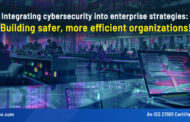The global COVID-19 pandemic has affected all sectors of the workplace. In response to employers’ increasing demands for employees to work remotely, remote work has become more popular than ever as businesses across all sectors seek to stay connected no matter where they are located. Many work environments have transitioned into hybrid workplaces since the pandemic subsided. Cybersecurity breaches have increased in the workplace due to this new approach used by employers and IT specialists.
Utilising VPNs, which permitted employees to work remotely while still enjoying connectivity and protection, was the first security precaution firms embraced during the epidemic. However, despite their widespread use, VPN authentication can give nefarious outsiders free network access, enabling them to compromise the digital assets of an organisation.
Organisations should think about using hybrid workplace network security to counter these threats. The future of an organisation can be secured by investing in its cybersecurity; today, cybersecurity is just as crucial to a company’s success and continuity as the door lock was in the past.
The following article will go through the many kinds of network security breaches to be on the lookout for. Then, we’ll go over strategies you can use to create a hybrid workplace security system and reduce the danger of giving nefarious outsiders full network access.
There are three different hybrid network security breaches to be aware of.
Every hybrid office network has potential flaws in interpersonal communications, old software, and misinformed workers, among other things. Even even minor cybersecurity lapses can provide hackers access to private data, which may result in the disclosure of crucial information.
This is a severe issue because, according to recent surveys, data leakage has previously affected 45% of American companies. Workplace network security must become a top responsibility as hybrid and remote workplaces become more common.
Here are three different kinds of security breaches to be aware of.
1. Phishing attacks
Phishing is one kind of cybersecurity assault. Phishing is when a hacker tries to deceive employees or coworkers into disclosing private information, allowing access to secured files, or accidentally downloading dangerous software.
A phishing scam is perpetrated by hackers who imitate an employee’s style of writing, personality, or company presence. 80% of breaches involve compromised identities, which can cause a domino effect and result in larger-scale cyber attacks that affect the entire company.
2. Ransomware attacks
Cybersecurity breaches can also be caused by ransomware. A ransomware attack encrypts files on an organization’s network and then demands payment to unlock them. Basically, they gain access to the workplace network and begin to hold it, hostage, demanding a ransom to keep any sensitive work data from leaked.
Ransomware can be installed on a network by using phishing.
3. Man-in-the-Middle attacks
A third type of cybersecurity breach is a man-in-the-middle attack, in which a hacker intercepts and alters communications between two parties in order to steal data or manipulate transactions. A phishing attack can also be a man-in-the-middle attack.
Here are six practices for establishing hybrid workplace security
Establishing a comprehensive, multifaceted system of defence is the best way to combat potential cyberattacks.
By combining different approaches, such as cyber education in the workplace and awareness of smart purchasing decisions, we can shore up our defences before an attack occurs. Meanwhile, implementing specific preventive cybersecurity measures will ensure a more robust cybersecurity framework across the workplace in case of a malicious attack.
The following six practices can be used to create a hybrid workplace environment that is secure.
1. Choose trustworthy vendors
As a business owner, you work within a broader network of vendors, contractors, and clients. To ensure cybersecurity from the beginning, it is imperative that all business partners and vendors are thoroughly vetted before working together. For example, look for business phone services that include features like enhanced cyber protection and cyberattack insurance before signing a company-wide contract.
Employees and businesses should use specific transfer sources when requesting or sending money online. For preventing breaches during transactions, employers should make sure their bank transfers include digital security encryption and protection against chargebacks.
2. Adopt alternative remote access methods
Finding alternative remote access techniques is a good strategy to guarantee the continuous security of the office network because breaches of company networks covered by VPNs are happening more frequently.
Each device may simply sync across regional boundaries thanks to the software-defined perimeter’s cloud-based methodology. Every level of access is protected by a software-defined perimeter, which is based on identity validation before connecting users.
3. Introduce zero-trust network access
Zero-trust network access means that each and every request to access the corporate network, including requests from employees, must successfully pass numerous levels of authentication. By doing this, all employees—local and remote—will be required to follow the same high-level security measures.
Zero-trust network access also implies that each device is examined and verified, allowing for the tracking and identification of hackers or other bad actors posing as employees.
4. Develop cybersecurity training programs for the entire company
Establish training documents that can be accessed by both in-person and remote employees.
Maintaining constant awareness of cybersecurity threats among your entire staff and setting clear and direct actions employees can take if they suspect they have been targeted by a bad actor requires regular training on the latest cybersecurity protocols and procedures.
A secure workplace can be ensured by employees at every level of the organization being well-informed about phishing, one of the most popular methods of cyber-attacks.
5. Conduct regular cybersecurity tests
It is important for hybrid companies to identify potential weaknesses in their cybersecurity systems in order to prevent effective attacks.
Implement regular cybersecurity tests by having the internal IT team launch false phishing campaigns and try to simulate other hacking strategies. Your hybrid business may need to hire cybersecurity consultants to analyze its current cybersecurity defences if it does not have an entire IT team.
A cybersecurity software expert should also be consulted when choosing cybersecurity software for your business. Each workplace device should be updated regularly with the latest software and hardware. It would be beneficial to encourage employees to update their smartphone software as well as the software on other personal devices they may use for work purposes.
A hybrid workplace must manage cyber risk by updating software that contains the latest cybersecurity measures.
6. Ensure that all workplace devices are secured with eScan security software
Additionally, to personnel and alternative access networks, every workplace device should be equipped with cybersecurity protective software. By installing a firewall on every computer and tablet at work, you can protect the hard drive’s core from malicious software.
An effective firewall is able to protect the company’s network from any suspicious activity attempts. Secure remote access methods coupled with a powerful firewall enable the workplace network to be protected from illicit access attempts by cybercriminals with malicious intent.
Data diodes are another solution for securing networks. In contrast to software firewalls, data diodes function more as physical separators than identity barriers. Each incoming action request is analyzed and vetted by firewalls, but each electronic transaction is isolated by data diodes. A system failure would result in a total lack of connectivity between parts, even in the case of a system failure. Cybercriminals would still be unable to gain access to company information this way.
Final thoughts
Because hybrid workplaces combine in-person employees with remote workers, hybrid companies face unique challenges. A cybersecurity policy must encompass both types of employees, which can be challenging across the board.
Hybrid companies can boost workplace training programs and install higher-level security software to prevent phishing attacks, ransomware, malware, identity theft, and other malicious attacks. By taking these steps, sensitive personal information and company data will be protected from attacks and minimised damage in the case of a cybersecurity breach.







